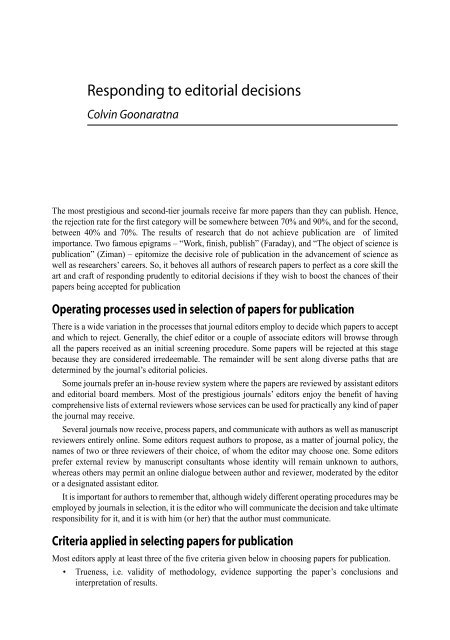South-East Asia Regional Conference on Epidemiology
South-East Asia Regional Conference on Epidemiology
South-East Asia Regional Conference on Epidemiology
You also want an ePaper? Increase the reach of your titles
YUMPU automatically turns print PDFs into web optimized ePapers that Google loves.
Resp<strong>on</strong>ding to editorial decisi<strong>on</strong>s<br />
Colvin Go<strong>on</strong>aratna<br />
The most prestigious and sec<strong>on</strong>d-tier journals receive far more papers than they can publish. Hence,<br />
the rejecti<strong>on</strong> rate for the first category will be somewhere between 70% and 90%, and for the sec<strong>on</strong>d,<br />
between 40% and 70%. The results of research that do not achieve publicati<strong>on</strong> are of limited<br />
importance. Two famous epigrams – “Work, finish, publish” (Faraday), and “The object of science is<br />
publicati<strong>on</strong>” (Ziman) – epitomize the decisive role of publicati<strong>on</strong> in the advancement of science as<br />
well as researchers’ careers. So, it behoves all authors of research papers to perfect as a core skill the<br />
art and craft of resp<strong>on</strong>ding prudently to editorial decisi<strong>on</strong>s if they wish to boost the chances of their<br />
papers being accepted for publicati<strong>on</strong><br />
Operating processes used in selecti<strong>on</strong> of papers for publicati<strong>on</strong><br />
There is a wide variati<strong>on</strong> in the processes that journal editors employ to decide which papers to accept<br />
and which to reject. Generally, the chief editor or a couple of associate editors will browse through<br />
all the papers received as an initial screening procedure. Some papers will be rejected at this stage<br />
because they are c<strong>on</strong>sidered irredeemable. The remainder will be sent al<strong>on</strong>g diverse paths that are<br />
determined by the journal’s editorial policies.<br />
Some journals prefer an in-house review system where the papers are reviewed by assistant editors<br />
and editorial board members. Most of the prestigious journals’ editors enjoy the benefit of having<br />
comprehensive lists of external reviewers whose services can be used for practically any kind of paper<br />
the journal may receive.<br />
Several journals now receive, process papers, and communicate with authors as well as manuscript<br />
reviewers entirely <strong>on</strong>line. Some editors request authors to propose, as a matter of journal policy, the<br />
names of two or three reviewers of their choice, of whom the editor may choose <strong>on</strong>e. Some editors<br />
prefer external review by manuscript c<strong>on</strong>sultants whose identity will remain unknown to authors,<br />
whereas others may permit an <strong>on</strong>line dialogue between author and reviewer, moderated by the editor<br />
or a designated assistant editor.<br />
It is important for authors to remember that, although widely different operating procedures may be<br />
employed by journals in selecti<strong>on</strong>, it is the editor who will communicate the decisi<strong>on</strong> and take ultimate<br />
resp<strong>on</strong>sibility for it, and it is with him (or her) that the author must communicate.<br />
Criteria applied in selecting papers for publicati<strong>on</strong><br />
Most editors apply at least three of the five criteria given below in choosing papers for publicati<strong>on</strong>.<br />
• Trueness, i.e. validity of methodology, evidence supporting the paper’s c<strong>on</strong>clusi<strong>on</strong>s and<br />
interpretati<strong>on</strong> of results.









